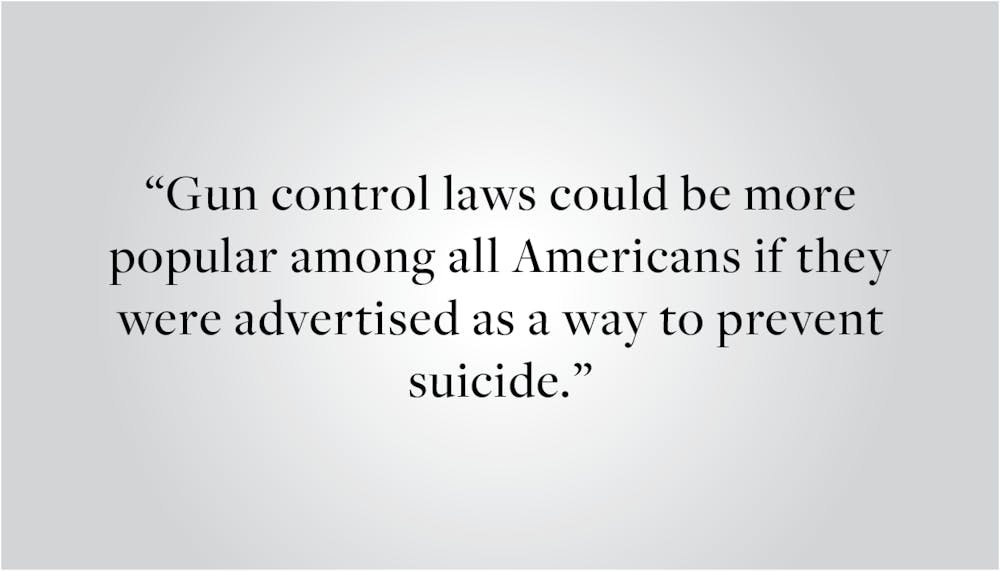Content warning: This article contains discussions of gun violence and suicide.
If you or someone you know needs help, contact Counseling and Psychological Services at 401-863-3476 or, for immediate help, Brown EMS at 401-863-4111 or the Department of Public Safety (DPS) at 401-863-4111.
You can also call the National Suicide Prevention Lifeline at 988. Additionally, you can text the Crisis Text Line at 741741.
The recent spate of mass shootings in the U.S. has once again brought the topic of gun control to the forefront of national discourse. Shootings can dominate the media for days and result in political division and vilification of both the left and the right.
But what if even despite all this attention, both we and the media are missing a crucial aspect of this issue? Horrifying as they are, mass shootings account for just a small percentage of gun deaths nationwide; the majority of gun deaths are actually suicides. In 2021, for example, the Gun Violence Archive counted 706 deaths from mass shootings — though the term does not have one definition. The same year, more than 26,000 people died of gun-related suicides. Gun control laws could do more to focus directly on this problem. Laws that require guns to be stored, locked and unloaded are proven to decrease suicides, especially among young people. Mandatory waiting periods after gun purchases save lives by preventing people considering suicide from acting immediately. We need laws and discussions like these to explicitly address the relationship between gun control and suicide.
Restricting gun sales as a a suicide prevention measure is especially compelling policy because easier access to guns directly correlates with increased suicide rates. It has been proven that simply owning a gun elevates a person’s risk of suicide, regardless of the state of their mental health. For example, a 1999 study showed that those who bought a gun were 57 times more at risk for suicide the next week after the purchase. Their risk of suicide stayed elevated for six years after the gun was bought. Furthermore, general gun ownership and suicide rates have been proven to rise in tandem. Today, over half of all suicides are firearm-inflicted.
Some may argue that gun control laws will not reduce suicide numbers but will rather lead to other methods becoming more prevalent. This is not the case. The vast majority of people who attempt suicide and survive do not attempt again. But when guns are the weapon of choice, people rarely survive: 90% of people who use a gun in a suicide attempt die compared to the 4% death rate among all other methods.
Passing gun laws to prevent suicide and diverting resources to suicide prevention more generally may even avert some mass shootings. First and foremost, mass shootings are often also suicides — 78% of mass shooters have a history of suicidal ideation, have attempted suicide or both. Some of them even commit mass shootings with the intent of being killed by police. Most only decide to commit a shooting once they feel completely hopeless and turn their internal anger and hopelessness outward. If legislators focused on gun control initiatives that expand access to mental health resources for potential gun purchasers, these shootings could be avoided.
Gun control laws crafted to stop mass shootings are somewhat effective, but many studies of their efficacy yield mixed, inconclusive or statistically insignificant results. This makes an already entrenched political fight even more deadlocked.
Framing gun control laws as a way to prevent suicide is a politically easier way to pass gun control legislation — both Democrats and Republicans support anti-suicide mental health measures. In fact, most Americans, regardless of political affiliation, believe that the government should more actively support mental health, potentially by having mental health crisis teams replace or supplement police in certain situations and increasing funding for mental health treatment. Gun control bills that have been framed as suicide prevention measures have won political support in more conservative states, such as Utah, than other partisan gun control bills could. This may mean that gun control laws could be more popular among all Americans if they were advertised primarily as a way to prevent suicide. While mass shootings might seem distant, 33% of Americans know someone who died by suicide.
Writing gun control laws aimed at suicide prevention is the most effective way to save lives from gun violence. Suicides are the most common form of gun death, though they capture much less public attention than other forms of gun violence. Furthermore, anti-suicide gun laws are much more likely to actually get passed. If we truly want to save lives and avoid the political finger-pointing that dominates discussions of gun violence, we must shift our focus to suicide prevention.
Benjamin Aizenberg ’26 can be reached at benjamin_aizenberg@brown.edu. Please send responses to this opinion to letters@browndailyherald.com and other op-eds to opinions@browndailyherald.com





